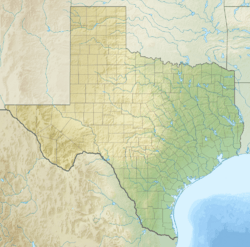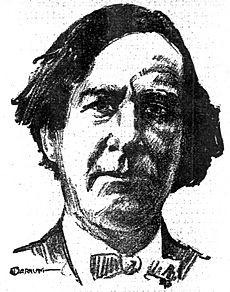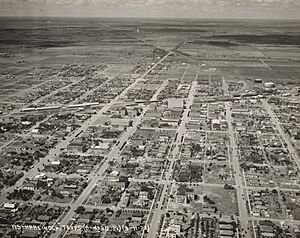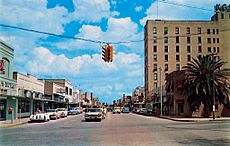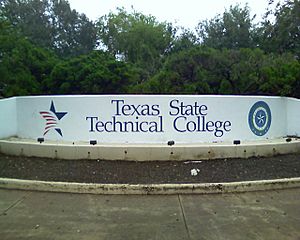Harlingen, Texas facts for kids
Quick facts for kids
Harlingen, Texas
|
|||||
|---|---|---|---|---|---|
| City of Harlingen | |||||
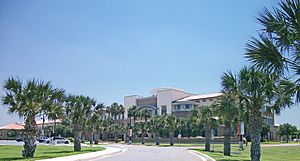
The University of Texas Rio Grande Valley School of Medicine
|
|||||
|
|||||
| Nickname(s):
"Capital City of the Valley", "H-Town"
|
|||||
| Motto(s):
"The Capital of the Rio Grande Valley"
|
|||||

Location in Cameron County and the state of Texas
|
|||||
| Country | United States | ||||
| State | Texas | ||||
| County | Cameron | ||||
| Founded | 1904 | ||||
| Named for | Harlingen, Netherlands | ||||
| Government | |||||
| • Type | Council-Manager | ||||
| Area | |||||
| • City | 40.63 sq mi (105.22 km2) | ||||
| • Land | 40.13 sq mi (103.93 km2) | ||||
| • Water | 0.50 sq mi (1.29 km2) | ||||
| Elevation | 39 ft (12 m) | ||||
| Population
(2020)
|
|||||
| • City | 71,829 | ||||
| • Estimate
(2021)
|
71,925 | ||||
| • Density | 1,767.88/sq mi (682.66/km2) | ||||
| • Metro | 406,220 | ||||
| Time zone | UTC−6 (CST) | ||||
| • Summer (DST) | UTC−5 (CDT) | ||||
| ZIP codes |
78550-78553
|
||||
| Area code(s) | 956 | ||||
| FIPS code | 48-32372 | ||||
| GNIS feature ID | 1337354 | ||||
Harlingen (pronounced HAR-lin-jin) is a city in Cameron County, Texas. It's located in the central part of the Rio Grande Valley. The city is about 30 miles (48 km) from the Gulf of Mexico coast.
Harlingen covers over 40 square miles (104 square kilometers). It is the second-largest city in Cameron County. It's also the fourth-largest city in the Rio Grande Valley. In 2020, about 71,892 people lived there. Harlingen is a main city in the Brownsville–Harlingen metropolitan area. This area is part of a larger region called the Matamoros–Brownsville metropolitan region.
Contents
History of Harlingen
Harlingen grew into an important center for shipping and industry. This was because of its location where two major roads meet: U.S. Route 77 and U.S. Route 83. These roads are now also known as Interstate 69 East and Interstate 2.
In 1904, a man named Lon C. Hill imagined using the Rio Grande river for trade. He founded a town on the north bank of the river. He named it after the city of Harlingen in the Netherlands. The town's post office opened that same year. The first school in Harlingen started in 1905 with 15 students. Harlingen officially became a city on April 15, 1910. At that time, its population was 1,126 people. By 1920, the population grew to 1,748. In its early days, Harlingen's economy was mostly based on farming, especially growing vegetables and cotton.
During World War II, military bases were built in Harlingen. This caused the population to jump from 23,000 in 1950 to 41,000 by 1960. The Harlingen Air Force Base closed in 1962. After the base closed, the city's population dropped to 33,603 by 1972. However, it then rose again to 40,824 by 1980. Local businesses worked to use the abandoned base and its housing. This helped the city's economy grow and become more diverse.
Today, the City of Harlingen runs a busy industrial airpark where military planes once landed. The Confederate Air Force (now called Commemorative Air Force) used to have hangars at Valley International Airport until 1991. The first hospital in Harlingen opened in 1923. It was a small hospital that later closed. The Valley Baptist Hospital was built nearby and grew into the Valley Baptist Medical Center. Harlingen now has many health-care experts and facilities. Other health centers include the South Texas State Chest Hospital and the Rio Grande State Mental Health Center.
Harlingen has public and church schools. Students can also attend the University Preparatory School, the Marine Military Academy, or Texas State Technical College. The city has many clubs and groups like Rotary, Kiwanis, and Lions. These groups help the community. Art and culture are supported by groups like the Rio Grande Valley Art League. The Rio Grande Valley Civic Association holds concerts at the Harlingen Municipal Auditorium. Every March, Harlingen hosts the Rio Grande Valley International Music Festival. The city has two newspapers: the Harlingen Press and the Valley Morning Star. In 1992, Harlingen was named an All-America City. This award recognized its volunteer spirit and self-help programs. By 2000, the city had 57,564 people and 2,549 businesses.
Geography and Climate
Harlingen has a total area of about 40.3 square miles (104.4 square kilometers). Most of this area is land, about 39.8 square miles (103.1 square kilometers). The rest, about 0.5 square miles (1.3 square kilometers), is water.
The soils in Harlingen are mostly sandy loam to clay. They are usually neutral to slightly alkaline. This means their pH is often around 8.2. Most of the soils drain water well.
Climate in Harlingen
Harlingen has a humid subtropical climate. This means it has long, very humid summers with hot days and warm nights. Winters are very dry with warm days and cool nights. The most rain falls in September. On average, about 5.76 inches (146 mm) of rain falls then.
| Climate data for Harlingen, Texas, 1991–2020 normals, extremes 1912–present | |||||||||||||
|---|---|---|---|---|---|---|---|---|---|---|---|---|---|
| Month | Jan | Feb | Mar | Apr | May | Jun | Jul | Aug | Sep | Oct | Nov | Dec | Year |
| Record high °F (°C) | 93 (34) |
99 (37) |
104 (40) |
107 (42) |
107 (42) |
106 (41) |
107 (42) |
108 (42) |
106 (41) |
100 (38) |
97 (36) |
93 (34) |
108 (42) |
| Mean maximum °F (°C) | 84.6 (29.2) |
88.3 (31.3) |
92.1 (33.4) |
95.1 (35.1) |
96.3 (35.7) |
99.1 (37.3) |
99.8 (37.7) |
100.8 (38.2) |
98.9 (37.2) |
94.4 (34.7) |
89.5 (31.9) |
85.4 (29.7) |
101.9 (38.8) |
| Mean daily maximum °F (°C) | 71.7 (22.1) |
76.0 (24.4) |
81.0 (27.2) |
86.4 (30.2) |
91.1 (32.8) |
95.4 (35.2) |
96.6 (35.9) |
97.8 (36.6) |
93.1 (33.9) |
88.0 (31.1) |
79.7 (26.5) |
73.2 (22.9) |
85.8 (29.9) |
| Daily mean °F (°C) | 61.4 (16.3) |
65.4 (18.6) |
70.5 (21.4) |
76.1 (24.5) |
81.5 (27.5) |
85.6 (29.8) |
86.8 (30.4) |
87.3 (30.7) |
83.4 (28.6) |
77.4 (25.2) |
69.3 (20.7) |
62.8 (17.1) |
75.6 (24.2) |
| Mean daily minimum °F (°C) | 51.1 (10.6) |
54.8 (12.7) |
60.0 (15.6) |
65.9 (18.8) |
71.8 (22.1) |
75.9 (24.4) |
76.9 (24.9) |
76.8 (24.9) |
73.6 (23.1) |
66.8 (19.3) |
58.8 (14.9) |
52.5 (11.4) |
65.4 (18.6) |
| Mean minimum °F (°C) | 35.9 (2.2) |
39.6 (4.2) |
43.3 (6.3) |
51.1 (10.6) |
59.9 (15.5) |
70.1 (21.2) |
72.2 (22.3) |
72.4 (22.4) |
64.9 (18.3) |
51.4 (10.8) |
42.3 (5.7) |
36.3 (2.4) |
33.5 (0.8) |
| Record low °F (°C) | 14 (−10) |
21 (−6) |
29 (−2) |
37 (3) |
46 (8) |
57 (14) |
60 (16) |
60 (16) |
52 (11) |
33 (1) |
29 (−2) |
15 (−9) |
14 (−10) |
| Average precipitation inches (mm) | 1.22 (31) |
1.19 (30) |
1.49 (38) |
2.29 (58) |
2.73 (69) |
2.37 (60) |
2.44 (62) |
2.07 (53) |
5.76 (146) |
3.06 (78) |
2.00 (51) |
1.58 (40) |
28.20 (716) |
| Average snowfall inches (cm) | 0.0 (0.0) |
0.0 (0.0) |
0.0 (0.0) |
0.0 (0.0) |
0.0 (0.0) |
0.0 (0.0) |
0.0 (0.0) |
0.0 (0.0) |
0.0 (0.0) |
0.0 (0.0) |
0.0 (0.0) |
0.1 (0.25) |
0.1 (0.25) |
| Average precipitation days (≥ 0.01 in) | 7.5 | 5.8 | 5.8 | 4.8 | 4.9 | 6.5 | 5.1 | 5.9 | 10.5 | 6.3 | 6.3 | 7.5 | 76.9 |
| Average snowy days (≥ 0.1 in) | 0.0 | 0.0 | 0.0 | 0.0 | 0.0 | 0.0 | 0.0 | 0.0 | 0.0 | 0.0 | 0.0 | 0.0 | 0 |
| Source 1: NOAA | |||||||||||||
| Source 2: National Weather Service | |||||||||||||
People Living in Harlingen
| Historical population | |||
|---|---|---|---|
| Census | Pop. | %± | |
| 1920 | 1,784 | — | |
| 1930 | 12,124 | 579.6% | |
| 1940 | 13,306 | 9.7% | |
| 1950 | 23,229 | 74.6% | |
| 1960 | 41,207 | 77.4% | |
| 1970 | 33,503 | −18.7% | |
| 1980 | 43,543 | 30.0% | |
| 1990 | 48,735 | 11.9% | |
| 2000 | 57,564 | 18.1% | |
| 2010 | 64,849 | 12.7% | |
| 2020 | 71,829 | 10.8% | |
| 2021 (est.) | 71,925 | 10.9% | |
| U.S. Decennial Census | |||
Harlingen's Population in 2020
| Race | Number | Percentage |
|---|---|---|
| White (NH) | 10,826 | 15.07% |
| Black or African American (NH) | 572 | 0.8% |
| Native American or Alaska Native (NH) | 102 | 0.14% |
| Asian (NH) | 915 | 1.27% |
| Pacific Islander (NH) | 27 | 0.04% |
| Some Other Race (NH) | 143 | 0.2% |
| Mixed/Multi-Racial (NH) | 542 | 0.75% |
| Hispanic or Latino | 58,702 | 81.72% |
| Total | 71,829 |
In 2020, the 2020 United States census counted 71,829 people living in Harlingen. There were 21,752 households and 15,548 families.
Education in Harlingen
Schools for Kids and Teens
The city is served by the Harlingen Consolidated Independent School District. It is also part of the South Texas Independent School District. Harlingen has four high schools: Harlingen Collegiate High, Harlingen High School, Harlingen High School South, and Harlingen School of Health Professions. There is also a freshman academy called Dr. Abraham P. Cano Freshman Academy.
Saint Anthony Catholic School is a private school for grades K-8. It also has a Montessori program for younger children. The Marine Military Academy is a private school for boys in Harlingen. It helps students prepare for college.
Colleges and Universities
In 1967, a branch of Texas State Technical College opened in Harlingen. This two-year college offers over 30 programs to more than 5,000 students.
In 2002, the University of Texas Health Science Center at San Antonio opened a medical education center in Harlingen. Later, in 2012, the University of Texas at Brownsville and the University of Texas-Pan American joined together. They formed the University of Texas Rio Grande Valley (UTRGV). The University of Texas Rio Grande Valley School of Medicine also started, using resources from the Harlingen center. The first medical students began classes in 2016. UTRGV's psychiatry program is based in Harlingen.
Southern Careers Institute also has a campus in Harlingen.
Sports and Fun Activities
Harlingen used to have a minor league baseball team called the Rio Grande Valley WhiteWings. They played from 1994 to 2003 and again from 2006 to 2015. In 2000, the WhiteWings won the Texas-Louisiana League championship. Other baseball teams, like the Harlingen Capitals, also played here in the past. Famous baseball player Gaylord Perry played for the Rio Grande Valley Giants in 1960. All these teams played at Harlingen Field.
Valley Race Park is a racetrack for Greyhound dogs. It was the first dog track in Texas to allow betting. The building is air-conditioned and has many screens to watch races from across the U.S. The park closed in 1995 but reopened in 2000.
The World Birding Center has a location in Harlingen's Hugh Ramsey Nature Park. They are planning to build a new visitors' center there. This center will have a gift shop, an observation tower, and meeting rooms. Visitors can also find trails, maps, and restrooms at the park.
The Rio Grande Valley Birding Festival happens every November in Harlingen. It brings in up to 3,000 people each year. In 2018, the festival celebrated its 25th year.
J. Lewis Boggus Stadium is in downtown Harlingen. It has an artificial playing surface. It is used for football, soccer, and other sports events.
Healthcare Services
Harlingen has several hospitals and health centers.
- Harlingen Medical Center (HMC) is a hospital that opened in 2002. It has 112 beds and offers many services. These include heart surgery, emergency care, and services for children.
- Valley Baptist Medical Center (VBMC) is the largest hospital in the Rio Grande Valley, with 586 beds. It is the only Level II Trauma Center in the area. This means it can handle serious injuries. It also offers special care for strokes and has a newborn intensive-care unit.
- Solara Specialty Hospital Harlingen is a hospital for patients who need care for a longer time, sometimes up to a month. It has 41 beds.
- The Regional Academic Health Center is a teaching hospital. It is part of the University of Texas Health Science Center at San Antonio.
- Su Clinica Familiar offers healthcare services for families, focusing on dental care, women's health, and pediatrics. It mainly helps people with lower incomes.
- The Harlingen VA Outpatient Clinic and VA Health Care Center provide medical care for veterans.
- The Rio Grande State Center offers mental health services. It has a hospital for patients who need to stay overnight and a residential facility for longer programs. It also has an outpatient clinic for general medical care.
- A Ronald McDonald House opened in 1998. It provides a place for families to stay when their children are being treated for serious illnesses.
- Palms Behavioral Health is a mental and behavioral health facility. It opened in Harlingen in 2016 and has 94 beds.
Getting Around Harlingen
Airports
Valley International Airport is Harlingen's airport. It serves over two million people in the lower Rio Grande Valley and northern Mexico. The airport is in the northeastern part of Harlingen. It offers a way to cross the border through the Free Trade Bridge at Los Indios. The airport is a major cargo hub for the Rio Grande Valley. It works with companies like DHL, FedEx, and Southwest Airlines Cargo.
Southwest Airlines started flying to Harlingen in 1975. They now offer direct flights to Austin and Houston Hobby. Other airlines like United Express, American Airlines, Frontier Airlines, Delta Air Lines, and Sun Country Airlines also serve the airport.
Public Transportation
The city is working to build a public transit center for bus lines. This project is currently on hold.
Highways
Harlingen is located where U.S. Route 77 and U.S. Route 83 meet. These are also known as Interstate 69E and Interstate 2. Interstate 69E runs north-south through Harlingen. Interstate 2 starts in Harlingen and goes west. U.S. Route 77 connects the Rio Grande Valley to Interstate 37 in Corpus Christi. U.S. Route 83 connects the Rio Grande Valley to Interstate 35 in Laredo.
International Bridges
The Free Trade Bridge at Los Indios is an international bridge about 10 miles (16 km) south of Harlingen. It has a large U.S. Customs facility that can handle many trucks at once. This bridge is known for being a fast border crossing. It connects to a four-lane highway in northern Mexico. This highway offers a quick route to the border cities of Matamoros and Reynosa, and the industrial city of Monterrey.
Ports
The Port of Harlingen is located 4 miles (6.4 km) east of Harlingen on Highway 106. It is 25 miles (40 km) west of the Gulf Intracoastal Waterway. This waterway stretches along the entire coast of the Gulf of Mexico. It provides over 1,300 miles (2,092 km) of protected waterway. The Harlingen Channel is maintained to be 125 feet (38 m) wide and 12 feet (3.7 m) deep. It is fed by the Arroyo Colorado, a freshwater river.
Railroads
Union Pacific Railroad has a local terminal and switching yard in Harlingen. The Harlingen Industrial Parks and Port of Harlingen have direct access to the railway. Harlingen has a long history as a railroad town.
Culture and Fun Places
The Harlingen Public Library serves the people living in the city.
Other interesting places to visit include:
- Harlingen Arts and Heritage Museum
- Harlingen Performing Arts Theater
- Iwo Jima Memorial & Museum
- Hugh Ramsey Nature Park
News and Media
Newspapers
- Valley Morning Star
- The Brownsville Herald
- The Monitor
Television Channels
- KGBT-TV (Channel 4, Harlingen, Texas, Antenna TV Affiliate)
- KRGV-TV (Channel 5, Weslaco, Texas, ABC affiliate)
- KVEO (Channel 23, Brownsville, Texas, NBC/CBS affiliate)
- KTLM (Channel 40, Rio Grande City, Texas, Telemundo station)
- KNVO (Channel 48, McAllen, Texas, Univision affiliate)
- KFXV (Channel 60, Harlingen, Texas, FOX affiliate)
Radio Stations (FM)
- KHID 88.1 FM (PBS/NPR)
- KBNR 88.3 FM (Spanish Christian)
- KOIR Radio Esperanza 88.5 (Spanish Christian)
- KJJF 88.9 FM (PBS/NPR)
- XHMLS 91.3 FM (Top-40)
- KTER 90.7 FM (Religious)
- KCAS The New 91.5 (English Traditional Christian)
- KESO 92.7 FM (Spanish)
- KFRQ Q94.5 (Classic/Modern/Hard Rock)
- KBTQ Recuerdo 96.1 FM (Mexican Oldies)
- KVMV Family Friendly & Commercial Free 96.9 FM (Adult Contemporary Christian)
- KGBT-FM Solamente Exitos 98.5 FM (Mexican Norteña)
- KKPS Fuego 99.5 FM (Puro Trancazos)
- KTEX South Texas Country 100.3 FM (Country)
- KNVO-FM Jose 101.1 FM (Spanish Hits)
- KBUC 102.1 FM Super Tejano (Tejano)
- KBFM Wild 104.1 FM (Hip-Hop/R&B)
- KJAV Ultra 104.9 (Spanish Adult Hits)
- KQXX 105.5 FM "The X" (Classic Rock)
- XHNA 105.9 FM (Spanish)
- KBIC 105.7 FM (Spanish)
- KHKZ Kiss 106.3 FM (Hot AC)
- KVLY 107.9 RGV FM (AC)
Radio Stations (AM)
- KURV 710 AM (Talk)
- KVJY 840 AM (Spanish Pop)
- KRIO 910 AM (Spanish)
- KUBR 1210 AM (Spanish)
- KSOX 1240 AM (Spanish)
- KRGE 1290 AM (Spanish)
- XERDO 1060 AM (Spanish Talk)
- XEMS 1490 AM (Spanish)
- KGBT 1530 AM (Spanish)
- KIRT 1580 AM (Spanish)
- KVNS 1700 AM (Fox Sports)
Famous People From Harlingen
- Gloria E. Anzaldúa (1942–2004), writer
- Leo Araguz (born 1970), American football player
- Thomas Haden Church (born 1960), actor
- Parker Coppins, YouTuber
- Danielle Doty (born 1993), Miss Teen USA 2011
- Carlos Elizondo, event planner and political aide
- Cayetano Garza (born 1972), cartoonist
- Bill Haley (1925–1981), rock and roll musician
- Gina Haley (born 1975), singer-songwriter
- Harry Holt, professional football player
- Rose Wilder Lane (1886–1968), journalist and novelist
- Bobby Morrow (1935–2020), American sprinter who won three gold medals at the 1956 Olympics
- Harry Nyquist (1889–1976), electronics engineer
- Emmy Ruiz, political advisor
- Nick Stahl (born 1979), actor
- Jeffrey Thompson (born 1963), Idaho state representative
- Blanca Vela (1936–2014), first female mayor of Brownsville, Texas
- Filemon Vela Jr., U.S. Representative
- Larry Warner (1943–2022), lawyer and politician
- Randy Williams (born 1975), former Major League Baseball player
- Kim Young (born 1955), professional golfer
See also
 In Spanish: Harlingen (Texas) para niños
In Spanish: Harlingen (Texas) para niños




